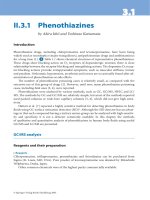Tài liệu Evidence-based Series 15-1 IN REVIEW : Screening for Skin Cancer doc
Bạn đang xem bản rút gọn của tài liệu. Xem và tải ngay bản đầy đủ của tài liệu tại đây (231.9 KB, 5 trang )
Evidence-based Series 15-1 IN REVIEW
Screening for Skin Cancer
L. From, L. Marrett, C. Rosen, C. Zwaal, M. Johnston, K. Bak, G. Sibbald, J. Fong, and V. Mai
A Quality Initiative of the
Program in Evidence-based Care (PEBC), Cancer Care Ontario (CCO)
Report Date: June 19, 2007
An assessment conducted in September 2011 placed Evidence-based Series (EBS) 15-1
IN REVIEW, which means that it is undergoing assessment for currency and relevance.
The PEBC has determined that it is still appropriate for this document to continue to
be available while this updating process unfolds.
EBS 15-1 is comprised of 3 sections
and is available on the CCO website ()
PEBC Cancer Screening page at:
Section 1:
Clinical Practice Guideline
Section 2:
Systematic Review
Section 3:
Guideline Development and External Review - Methods and Results
For information about the PEBC and the most current version of all reports,
please visit the CCO website at
or contact the PEBC office at:
Phone: 905-527-4322 ext. 42822 Fax: 905-526-6775 E-mail:
Guideline Citation (Vancouver Style): From L, Marrett L, Rosen C, Zwaal C, Johnston M, Bak K, et al.
Screening for skin cancer. Toronto (ON): Cancer Care Ontario; 2005 Feb [In review 2011 Sep]. Program
in Evidence-based Care Evidence-based Series.: 15-1 IN REVIEW.
EBS 15-1 IN REVIEW
PRACTICE GUIDELINE – page 1
Evidence-based Series #15-1: Section 1
Screening for Skin Cancer: A Clinical Practice Guideline
L. From, L. Marrett, C. Rosen, C. Zwaal, M. Johnston, K. Bak, G. Sibbald, J. Fong, and V. Mai
A Quality Initiative of the
Program in Evidence-based Care (PEBC), Cancer Care Ontario (CCO)
Report Date: June 19, 2007
Questions
1. Should primary care providers routinely perform total-body skin examination on members of
the general population to screen for melanoma, basal cell carcinoma, and squamous cell
carcinoma of the skin?
2. Should primary care providers routinely counsel members of the general population to
perform skin self-examination for early detection of melanoma, basal cell carcinoma, and
squamous cell carcinoma of the skin?
3. Should individuals at high risk for melanoma, basal cell carcinoma, and squamous cell
carcinoma of the skin be offered surveillance by a physician, including total-body skin
examination and counselling to perform skin self-examination?
4. What characteristics should clinicians assess in order to determine risk for melanoma, basal
cell carcinoma, and squamous cell carcinoma of the skin?
Recommendations
Very limited evidence was available to inform the following recommendations on
screening. No prospective studies have evaluated the impact of screening on survival, quality of
life, or morbidity from treatment for skin cancer nor are there data on the adverse effects of
screening for skin cancer. As experts in the treatment and epidemiology of skin cancer, the
guideline panel members were aware that some individuals are at increased risk for skin cancer
because of personal characteristics or history. They reviewed key papers on risk and identified
groups of patients who might be expected to benefit from increased surveillance for skin cancer.
Separate recommendations are offered for two groups at increased risk (very high risk and high
risk) and the general population.
Very high risk of skin cancer
Individuals with any of the following risk factors have a very high risk of skin cancer
(approximately 10 or more times the risk of the general population):
- on immunosuppressive therapy after organ transplantation,
- a personal history of skin cancer,
- two or more first-degree relatives with melanoma,
EBS 15-1 IN REVIEW
PRACTICE GUIDELINE – page 2
- more than 100 nevi in total or 5+ atypical nevi,
- have received more than 250 treatments with psoralen-ultraviolet A radiation (PUVA) for
psoriasis
- received radiation therapy for cancer as a child
Individuals at very high risk should be identified by their primary health care provider and
offered total body skin examination by a dermatologist or a trained health care provider on a
yearly basis. They should also be counselled about skin self-examination and skin cancer
prevention by a health care provider (e.g., physician, nurse practitioner, or public health
nurse). In the case of childhood cancer survivors, the site of radiation therapy should be
monitored.
High risk of skin cancer
Individuals with two or more of the main identified susceptibility factors are at a high risk for
skin cancer (roughly 5 times the risk of the general population):
- a first-degree relative with melanoma,
- many (50-100) nevi,
- one or more atypical (dysplastic) nevi,
- naturally red or blond hair,
- a tendency to freckle,
- skin that burns easily and tans poorly or not at all
Other factors that may influence the risk of skin cancers that are environmental include an
outdoor occupation, a childhood spent at less than latitude 35
0
, the use of tanning beds
during teens and twenties, and radiation therapy as an adult.
Individuals at high risk should be identified by their primary health care provider and
counselled about skin self-examination (specifically focused on the site of radiation for those
having had therapeutic radiation) and skin cancer prevention by a health care provider (e.g.,
physician, nurse practitioner, or public health nurse). High-risk individuals should be seen
once a year by a health care provider trained in screening for skin cancers.
The general population not at increased risk of skin cancer
There is at this time no evidence for or against skin cancer screening of the general
population at average risk of developing skin cancer.
Based on the limited evidence available at present, routine total body skin examination by
primary care providers is not recommended for individuals at average or low risk for skin
cancer (i.e., those not included in the increased risk groups described above).
Based on the limited evidence available at present, routine counselling on skin self-
examination by primary care providers is not recommended for individuals at average or low
risk for skin cancer.
Key Evidence
(Please see Section 2 for the complete systematic review of the evidence conducted by the Skin
Cancer Screening Guideline Panel)
The guideline panel reviewed three evidence-based guidelines on screening for skin cancer
(1-3), results from a pilot randomized controlled trial of a community-based screening
program, a comparative cohort study of work-place screening and a case-control study of
skin self-examination.
EBS 15-1 IN REVIEW
PRACTICE GUIDELINE – page 3
The pilot phase of a randomized trial demonstrated the feasibility of implementing a
screening program consisting of community education, general practitioner education and
screening clinics to promote self-screening and whole-body screening by general
practitioners. Early results detected an increase in the percentage of subjects reporting
whole-body skin examination by a physician (4).
The randomized trial and the work-place screening study both found that people were more
likely to perform skin self-examination if they had undergone a whole-body skin examination
by a physician (4,5).
A case-control study detected the reduced risk of melanoma and reduced mortality from
melanoma associated with skin self-examination (6).
Epidemiologic studies have found that people who have any of the following characteristics
have a very high risk of developing skin cancer: on immunosuppressive therapy after organ
transplantation, a personal history of skin cancer, two or more first-degree relatives with
melanoma, more than 100 nevi in total or 5+ atypical nevi, have received more than 250
treatments with PUVA for psoriasis, or received radiation therapy for cancer in childhood.
The risk of skin cancer is more than 10 times higher in these individuals than in the general
population.
There are other factors associated with significant but lower relative risks (roughly 5 times
the risk of the general population for multiple susceptibility factors), such as a first-degree
relative with melanoma, many (50-100) nevi, one or more atypical (dysplastic) nevi, naturally
red or blond hair, a tendency to freckle, or skin that burns easily and tans poorly or not at all.
Because risk is assumed to be multiplicative, overall risk can be estimated from the products
of the relative risk associated with each factor present in an individual. Those who have two
or more of the high-risk traits have a higher than average risk of developing skin cancer.
References
1. US Preventive Services Task Force. Screening for skin cancer: recommendations and
rationale. Am J Prev Med. 2001;20(3 Suppl):44-6.
2. Feightner J.W. Prevention of skin cancer. In: Canadian Task Force on the Periodic Health
Examination. Canadian guide to clinical preventive health care. Ottawa (Canada): Health
Canada; 1994. p. 850-9.
3. Australian Cancer Network (ACN). Clinical practice guidelines. The management of
cutaneous melanoma [monograph on the Internet]. Canberra (Australia): ACN & National
Health and Medical Research Council. 1999 [cited 2003 Feb]. Available from:
4. Aitken JF, Elwood JM, Lowe JB, Firman DW, Balanda KP, Ring IT. A randomised trial of
population screening for melanoma. J Med Screen. 2002;9(1):33-7.
5. Azizi E, Flint P, Sadetzki S, Solomon A, Lerman Y, Harari G, et al. A graded work site
intervention program to improve sun protection and skin cancer awareness in outdoor
workers in Israel. Cancer Causes Control. 2000;11(6):513-21.
6. Berwick M, Begg CB, Fine JA, Roush GC, Barnhill RL. Screening for cutaneous melanoma
by skin self-examination. J Natl Cancer Inst. 1996;88(1):17-23.
EBS 15-1 IN REVIEW
PRACTICE GUIDELINE – page 4
Funding
The PEBC is supported by the Ontario Ministry of Health and Long-Term Care through Cancer Care
Ontario. All work produced by the PEBC is editorially independent from its funding source.
Copyright
This report is copyrighted by Cancer Care Ontario; the report and the illustrations herein may not be
reproduced without the express written permission of Cancer Care Ontario. Cancer Care Ontario
reserves the right at any time, and at its sole discretion, to change or revoke this authorization.
Disclaimer
Care has been taken in the preparation of the information contained in this report. Nonetheless, any
person seeking to apply or consult the report is expected to use independent medical judgment in the
context of individual clinical circumstances or seek out the supervision of a qualified clinician. Cancer
Care Ontario makes no representation or guarantees of any kind whatsoever regarding the report content
or use or application and disclaims any responsibility for its application or use in any way.
Contact Information
For further information about this report, please contact Dr. Verna Mai; Chair, Screening Guidelines
Steering Committee; Cancer Care Ontario;
505 University Ave, 18
th
Floor, Toronto, ON M5G-1X3; Telephone: 416.971.9800 x2252
For information about the PEBC and the most current version of all reports,
please visit the CCO Web site at or contact the PEBC office at:
Phone: 905-527-4322 ext. 42822 Fax: 905 526-6775









